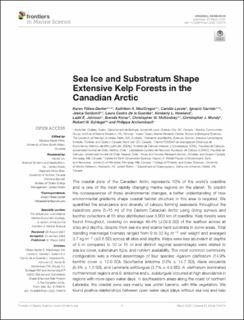| dc.contributor.author | Filbee-Dexter, Karen | |
| dc.contributor.author | MacGregor, Kathleen A. | |
| dc.contributor.author | Lavoie, Camille | |
| dc.contributor.author | Garrido, Ignacio | |
| dc.contributor.author | Goldsmit, Jesica | |
| dc.contributor.author | Castro de la Guardia, Laura | |
| dc.contributor.author | Howland, Kimberly L. | |
| dc.contributor.author | Johnson, Ladd E. | |
| dc.contributor.author | Konar, Brenda | |
| dc.contributor.author | McKindsey, Christopher W. | |
| dc.contributor.author | Mundy, Christopher J. | |
| dc.contributor.author | Schlegel, Robert W. | |
| dc.contributor.author | Archambault, Philippe | |
| dc.date.accessioned | 2022-07-13T12:06:55Z | |
| dc.date.available | 2022-07-13T12:06:55Z | |
| dc.date.created | 2022-06-10T13:44:46Z | |
| dc.date.issued | 2022 | |
| dc.identifier.citation | Frontiers in Marine Science. 2022, 9 . | en_US |
| dc.identifier.issn | 2296-7745 | |
| dc.identifier.uri | https://hdl.handle.net/11250/3005049 | |
| dc.description.abstract | The coastal zone of the Canadian Arctic represents 10% of the world’s coastline and is one of the most rapidly changing marine regions on the planet. To predict the consequences of these environmental changes, a better understanding of how environmental gradients shape coastal habitat structure in this area is required. We quantified the abundance and diversity of canopy forming seaweeds throughout the nearshore zone (5–15 m) of the Eastern Canadian Arctic using diving surveys and benthic collections at 55 sites distributed over 3,000 km of coastline. Kelp forests were found throughout, covering on average 40.4% (±29.9 SD) of the seafloor across all sites and depths, despite thick sea ice and scarce hard substrata in some areas. Total standing macroalgal biomass ranged from 0 to 32 kg m–2 wet weight and averaged 3.7 kg m–2 (±0.6 SD) across all sites and depths. Kelps were less abundant at depths of 5 m compared to 10 or 15 m and distinct regional assemblages were related to sea ice cover, substratum type, and nutrient availability. The most common community configuration was a mixed assemblage of four species: Agarum clathratum (14.9% benthic cover ± 12.0 SD), Saccharina latissima (13% ± 14.7 SD), Alaria esculenta (5.4% ± 1.2 SD), and Laminaria solidungula (3.7% ± 4.9 SD). A. clathratum dominated northernmost regions and S. latissima and L. solidungula occurred at high abundance in regions with more open water days. In southeastern areas along the coast of northern Labrador, the coastal zone was mainly sea urchin barrens, with little vegetation. We found positive relationships between open water days (days without sea ice) and kelp biomass and seaweed diversity, suggesting kelp biomass could increase, and the species composition of kelp forests could shift, as sea ice diminishes in some areas of the Eastern Canadian Arctic. Our findings demonstrate the high potential productivity of this extensive coastal zone and highlight the need to better understand the ecology of this system and the services it provides. | en_US |
| dc.language.iso | eng | en_US |
| dc.title | Sea Ice and Substratum Shape Extensive Kelp Forests in the Canadian Arctic | en_US |
| dc.title.alternative | Sea Ice and Substratum Shape Extensive Kelp Forests in the Canadian Arctic | en_US |
| dc.type | Peer reviewed | en_US |
| dc.type | Journal article | en_US |
| dc.description.version | publishedVersion | en_US |
| dc.source.pagenumber | 0 | en_US |
| dc.source.volume | 9 | en_US |
| dc.source.journal | Frontiers in Marine Science | en_US |
| dc.identifier.doi | 10.3389/fmars.2022.754074 | |
| dc.identifier.cristin | 2030840 | |
| cristin.ispublished | true | |
| cristin.fulltext | original | |
| cristin.qualitycode | 1 | |
